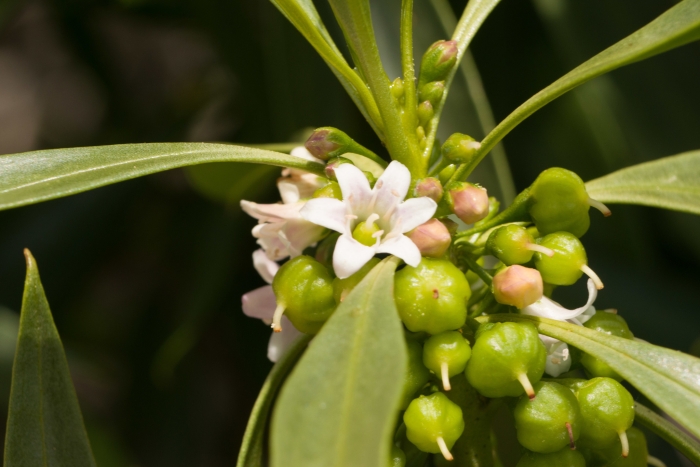Naio
(Myoporum sandwicense)
Naio (Myoporum sandwicense)
/
/

Kevin Faccenda
CC BY 4.0
Image By:
Kevin Faccenda
Recorded By:
Copyright:
CC BY 4.0
Copyright Notice:
Photo by: Kevin Faccenda | License Type: CC BY 4.0 | License URL: http://creativecommons.org/licenses/by/4.0/ | Rights Holder: Kevin Faccenda | Publisher: iNaturalist | Date Created: 2021-04-25T12:45:16-07:00 |

























































Estimated Native Range
Summary
Myoporum sandwicense, commonly known as Naio or False Sandalwood, is an evergreen shrub or small tree native to coastal areas, dry forests, and lava plains in Hawaii. This species typically grows to a height of 15-25 feet (4.5-7.6 meters) and a width of 8-12 feet (2.4-3.7 meters). It has a rounded form with dense foliage and small, lanceolate leaves. The white flowers, which appear in clusters, are small but fragrant and bloom sporadically throughout the year, with a peak in spring and summer. The flowers are followed by small, purple, non-edible fruits.
Naio is valued for its hardiness and adaptability to poor soils, making it suitable for xeriscaping and coastal plantings where wind and salt spray are common. It is often used as an ornamental plant in Hawaiian landscapes for its attractive foliage and flowers. Naio requires minimal care once established, thriving in full sun and tolerating drought conditions. It prefers well-drained soils and can be susceptible to root rot if overwatered. While generally pest-resistant, it can be affected by a recently introduced pest, the Myoporum thrips, which causes galling on the leaves. To prevent this, regular monitoring and integrated pest management practices are recommended. Naio is not typically invasive but can spread in suitable conditions.CC BY-SA 4.0
Naio is valued for its hardiness and adaptability to poor soils, making it suitable for xeriscaping and coastal plantings where wind and salt spray are common. It is often used as an ornamental plant in Hawaiian landscapes for its attractive foliage and flowers. Naio requires minimal care once established, thriving in full sun and tolerating drought conditions. It prefers well-drained soils and can be susceptible to root rot if overwatered. While generally pest-resistant, it can be affected by a recently introduced pest, the Myoporum thrips, which causes galling on the leaves. To prevent this, regular monitoring and integrated pest management practices are recommended. Naio is not typically invasive but can spread in suitable conditions.CC BY-SA 4.0
Plant Description
- Plant Type: Tree, Shrub
- Height: 15-25 feet
- Width: 8-12 feet
- Growth Rate: Rapid
- Flower Color: White
- Flowering Season: Spring, Summer, Fall, Winter
- Leaf Retention: Evergreen
Growth Requirements
- Sun: Full Sun
- Water: Low
- Drainage: Fast
Common Uses
Bee Garden, Butterfly Garden, Deer Resistant, Low Maintenance
Natural Habitat
Coastal areas, dry forests, and lava plains in Hawaii
Other Names
Common Names: Bastard Sandalwood, Naio
Scientific Names: , Myoporum sandwicense, Myoporum sandwicense var. sandwicense, Myoporum sandwicense var. fauriei, Myoporum fauriei, Myoporum sandwicense var. degeneri, Myoporum sandwicense subsp. lanaiense, Myoporum lanaiense, Myoporum sandwicense var. lanaiense, Myoporum degeneri
GBIF Accepted Name: Myoporum sandwicense (A.DC.) Gray